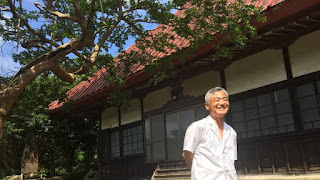The red-roofed temple at the top of the hill closed about a decade ago, and now Yoshihiro Shibata can’t even remember its name, though the 54-year-old dairy farmer has lived in this picturesque village all his life.
“The income of the temple depends on the number of residents, and there weren’t enough to keep a monk here,” he said, looking around the deserted grounds nestled amid the village’s lush landscape of tea plants and hydrangeas, bamboo and pine trees.
 A few years after the temple shut its doors, the village tea-processing factory closed down and the elementary school too. Now, the remaining students are bused an hour away.
A few years after the temple shut its doors, the village tea-processing factory closed down and the elementary school too. Now, the remaining students are bused an hour away.
“When I was young, we had about 100 kids here, but now there are just five,” Shibata said.
The local Shinto shrine is barely hanging on. With only about 250 households left in Hara-izumi, which is technically part of nearby Kakegawa city, the village no longer has enough men to hoist up the traditional float and parade it around during the shrine’s annual festival.
“They just set it out there and it doesn’t move,” Shibata said. In a few more years, even that may not be possible. “We’re supposed to lose half our population in the next decade.”
All across Japan, aging villages such as Hara-izumi have been quietly hollowing out for years, even as urban areas have continued to grow modestly. But like a creaky wooden roller coaster that slows at the top of the climb before plunging into a terrifying, steep descent, Japan’s population crested around 2010 with 128 million people and has since lost about 900,000 residents, last year’s census confirmed.
Now, the country has begun a white-knuckle ride in which it will shed about one-third of its population — 40 million people — by 2060, experts predict. In 30 years, 39% of Japan’s population will be 65 or older.
If the United States experienced a similar population contraction, it would be like losing every single inhabitant of California, New York, Texas and Florida — more than 100 million people.
Though demographers have long anticipated the transformation Japan is now facing, the country only now seems to be sobering up to the epic metamorphosis at hand.
Police and firefighters are grappling with the safety hazards of a growing number of vacant buildings. Transportation authorities are discussing which roads and bus lines are worth maintaining and cutting those they can no longer justify. Aging small-business owners and farmers are having trouble finding successors to take over their enterprises. Each year, the nation is shuttering 500 schools.
“Now, in every area — land planning, urban planning, economic planning — every branch of government is trying to do what they can,” said Reiko Hayashi, a researcher at the National Institute of Population and Social Security Research.
by Julie Makinen, LA Times | Read more:
Image:Julie Makinen / Los Angeles Times
“The income of the temple depends on the number of residents, and there weren’t enough to keep a monk here,” he said, looking around the deserted grounds nestled amid the village’s lush landscape of tea plants and hydrangeas, bamboo and pine trees.
 A few years after the temple shut its doors, the village tea-processing factory closed down and the elementary school too. Now, the remaining students are bused an hour away.
A few years after the temple shut its doors, the village tea-processing factory closed down and the elementary school too. Now, the remaining students are bused an hour away.“When I was young, we had about 100 kids here, but now there are just five,” Shibata said.
The local Shinto shrine is barely hanging on. With only about 250 households left in Hara-izumi, which is technically part of nearby Kakegawa city, the village no longer has enough men to hoist up the traditional float and parade it around during the shrine’s annual festival.
“They just set it out there and it doesn’t move,” Shibata said. In a few more years, even that may not be possible. “We’re supposed to lose half our population in the next decade.”
All across Japan, aging villages such as Hara-izumi have been quietly hollowing out for years, even as urban areas have continued to grow modestly. But like a creaky wooden roller coaster that slows at the top of the climb before plunging into a terrifying, steep descent, Japan’s population crested around 2010 with 128 million people and has since lost about 900,000 residents, last year’s census confirmed.
Now, the country has begun a white-knuckle ride in which it will shed about one-third of its population — 40 million people — by 2060, experts predict. In 30 years, 39% of Japan’s population will be 65 or older.
If the United States experienced a similar population contraction, it would be like losing every single inhabitant of California, New York, Texas and Florida — more than 100 million people.
Though demographers have long anticipated the transformation Japan is now facing, the country only now seems to be sobering up to the epic metamorphosis at hand.
Police and firefighters are grappling with the safety hazards of a growing number of vacant buildings. Transportation authorities are discussing which roads and bus lines are worth maintaining and cutting those they can no longer justify. Aging small-business owners and farmers are having trouble finding successors to take over their enterprises. Each year, the nation is shuttering 500 schools.
“Now, in every area — land planning, urban planning, economic planning — every branch of government is trying to do what they can,” said Reiko Hayashi, a researcher at the National Institute of Population and Social Security Research.
by Julie Makinen, LA Times | Read more:
Image:Julie Makinen / Los Angeles Times